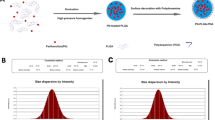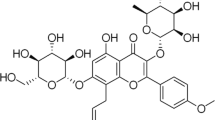Abstract
This paper provides a new treatment for gastric cancer with a new OMT delivery system. We synthesized MPEG-PCL, an amphiphilic polymer, to construct a nanoparticle encapsulated OMT by pH gradient method, and then examined the nanodrug’s therapeutic efficacy. An integral analytical method was used to characterize the structure of MPEG-PCL. The single factor method and orthogonal test were utilized to investigate the optimum preparation process. The morphology and average size of the OMT-NPs were analyzed by transmission electron microscopy and Zetasizer. CCK-8 assay and confocal fluorescent microscope were used to study the inhibitory effect on SGC-7901 gastric cancer cells. The average size of nanoparticles was 95.86±1.54 nm. The maximum encapsulation efficiency of OMT was 46.84±4.37%, while the drug loading content was 8.89±1.09%. The cumulative release of nanoparticles was 73.07±1.5%, inspected through dynamic dialysis in vitro. Compared with free OMT, OMT-NPs showed enhanced cytotoxic effects in SGC-7901 cells. The nanoparticles could efficiently deliver the OMT into the cancer cells and release it. The OMT delivery system prepared in this paper provides a potential platform for the treatment of gastric cancer.
Similar content being viewed by others
References
Corso S, Ghiso E, Cepero V, et al. Activation of HER Family Members in Gastric Carcinoma Cells Mediates Resistance to MET Inhibition[J]. Molecular Cancer, 2010, 9(1): 121–133
Hu Y, Zhao G, Zheng H. Therapeutic Effects of Laparotomy and Lapa-roscopic Surgery on Patients with Gastric Cancer[J]. Pakistan Journal of Medical Sciences, 2015, 31(3): 572–575
Zheng L, Wang L, Ajani J, et al. Molecular Basis of Gastric Cancer Development and Progression[J]. Gastric Cancer, 2004, 7(2): 61–77
Zhang J, Wang J, Guo Q, et al. LCH-7749944, A Novel and Potent p21-activated Kinase 4 Inhibitor, Suppresses Proliferation and Invasion in Human Gastric Cancer Cells[J]. Cancer Letters, 2012, 317(1): 24–32
Lu WW, Zhang R, Zhu JS, et al. Oxymatrine and Cancer Therapy[J]. European Journal of Inflammation, 2015, 13(3):148–153
Yan L, Bi T, Wei D, et al. Oxymatrine Synergistically Enhances the Inhibitory Effect of 5-fluorouracil on Hepatocellular Carcinoma in vitro and in vivo[J]. Tumor Biology, 2016, 37(6): 7 589–7 597
Pei Z, Zeng J, Gao Y, et al. Oxymatrine Inhibits the Proliferation of CaSki Cells Via Downregulating HPV16E7 Expression[J]. Oncology Reports, 2016, 36(1): 291–298
Yan L, Bi T, Zheng W, et al. Oxymatrine Synergistically Enhances Antitumor Activity of Oxaliplatin in Colon Carcinoma Through PI3K/AKT/mTOR Pathway[J]. Apoptosis An International Journal on Programmed Cell Death, 2016, 21(12): 1 398–1 408
Zhang R, Hu S, Chen X, et al. Screening and Research of Anti-Cancer Matrine Components Based on Hollow Fiber Cell Fishing with High-Performance Liquid Chromatography[J]. Chromatographia, 2016, 79(3–4): 125–136
Guo B, Zhang T, Su J, et al. Oxymatrine Targets EGFRp-Tyr845 and Inhibits EGFR-related Signaling Pathways to Suppress the Proliferation and Invasion of Gastric Cancer Cells[J]. Cancer Chemother Pharmacol, 2015, 75: 353–363
Zhang S, Wu J, Wang H, et al. Liposomal Oxymatrine in Hepatic Fibrosis Treatment: Formulation, in vitro and in vivo Assessment[J]. Aaps Pharmscitech, 2014, 15(3): 620–629
Deng Y. Studies on the Encapsulation of Oxymatrine into Liposomes by Ethanol Injection and pH Gradient Method[J]. Drug Development & Industrial Pharmacy, 2006, 32(7): 791–797
Choi C, Lee HY, Jeong YI, et al. Synthesis of Methoxy poly(ethylene glycol)-b -poly(dl-lactide-co-glycolide) Copolymer Via Diselenide Linkage and Fabrication of Ebselen-incorporated Nanoparticles for Radio-responsive drug Delivery[J]. Journal of Industrial & Engineering Chemistry, 2016, 47: 112–120
Zhou Y, He C, Chen K, et al. A New Method for Evaluating Actual Drug Release Kinetics of Nanoparticles inside Dialysis Devices via Numerical Deconvolution.[J]. Journal of Controlled Release, 2016, 243: 11–20
Jin N, Zhao YX, Deng SH, et al. Preparation and in vitro Anticancer Activity of Oxymatrine Mixed Micellar Nanoparticles[J]. Die Pharmazie, 2011, 66(7): 506–510
Danhier F, Feron O, Préat V. To Exploit, the Tumor, Microenvironment: Passive, and Active, Tumor, Targeting, of Nanocarriers, for Anti-cancer, Drug, Delivery[J]. Journal of Controlled Release, 2010, 148(2): 135–146
Zhang D, Zou Z, Ren W, et al. Gambogic Acid-loaded PEG-PCL Nanoparticles Act as an Effective Antitumor Agent Against Gastric Cancer[J]. Pharmaceutical Development & Technology, 2017, 23(1): 1–8
Wang Y, Wan G, Li Z, et al. PEGylated Doxorubicin Nanoparticles Mediated by HN-1 Peptide for Targeted Treatment of Oral Squamous Cell Carcinoma[J]. International Journal of Pharmaceutics, 2017, 525(1): 21–31
Qin JJ, Wang W, Sarkar S, et al. Oral Delivery of Anti-MDM2 Inhibitor SP141-loaded FcRn-targeted Nanoparticles to Treat Breast Cancer and Metastasis[J]. Journal of Controlled Release, 2016, 237: 101–114
Wang Y, Chen L, Tan L, et al. PEG-PCL Based Micelle Hydrogels as Oral Docetaxel Delivery Systems for Breast Cancer Therapy[J]. Biomaterials, 2014, 35(25): 6 972–6 985
Zhang L, Chen Z, Wang H, et al. Preparation and Evaluation of PCL-PEG-PCL polymeric Nanoparticles for Doxorubicin Delivery Against Breast Cancer[J]. Rsc Advances, 2016, 6(60): 54 727–54 737
Cui FB, Liu Q, Li RT, et al. Enhancement of Radiotherapy Efficacy by miR-200c-loaded Gelatinase-stimuli PEG-Pep-PCL Nanoparticles in Gastric Cancer Cells[J]. International Journal of Nanomedicine, 2014, 9(1): 2 345–2 358
Meng F, Hiemstra C, Engbers GHM, et al. Biodegradable Polymer-somes[J]. Macromolecules, 2003, 36(9): 3 004–3 006
Katz JS, Levine DH, Davis KP, et al. Membrane Stabilization of Biodegradable Polymersomes[J]. Langmuir the Acs Journal of Surfaces & Colloids, 2009, 25(8): 4 429–4 434
Zhang D, Chen K, Wu L, et al. Synthesis and Characterization of PVA-HA-Silk Composite Hydrogel by Orthogonal Experiment[J]. Journal of Bionic Engineering, 2012, 9(2): 234–242
And RAV, Maguire JF. Polymer Nanocomposites with Prescribed Morphology: Going beyond Nanoparticle-Filled Polymers[J]. Chemistry of Materials, 2007, 19(11): 2 736–2 751
Prabu P, Chaudhari AA, Ko JA, et al. Cellular Uptake and In Vitro Drug Release Studies on Paclitaxel-Loaded Poly(caprolactone)-Grafted Dextran Copolymeric Nanoparticles[J]. Nanobiotechnology, 2009, 5(1–4): 42–49
Zhu JS, Xu ZP, Song MQ, et al. Effect of Oxymatrine Combined with Low Dose 5-Fu on Lymphatic Vessel and Microvascular Endothelial Cell Growth of Gastric Cancer in a Severe Combined Immunodeficient Mouse Orthotopic Implantation Model[J]. European Journal of Inflammation, 2011, 9(1): 45–51
Wang Y, Zheng WY, Menggen DL, et al. Pharmacokinetic Study of OMT Injection in Chinese Healthy Volunteers[J]. Clin. Pharmacol, 2003, 19: 301–305
Li Z, Liu M, Wang H, et al. Increased Cutaneous Wound Healing Effect of Biodegradable Liposomes Containing Madecassoside: Preparation Optimization, in vitro Dermal Permeation, and in vivo Bioevalu-ation[J]. International Journal of Nanomedicine, 2016, 11: 2 995–3 007
Sulheim E, Baghirov H, Haartman E, et al. Cellular Uptake and Intra-cellular Degradation of Poly(Alkyl Cyanoacrylate) Nanoparticles[J]. Journal of Nanobiotechnology, 2016, 14(1): 1–14
Author information
Authors and Affiliations
Corresponding authors
Additional information
Funded by the National Natural Science Foundation of China (No. 51273156) and the Health Commission of Hubei Province Scientific Research Project (No. WJ2019H275)
Rights and permissions
About this article
Cite this article
Liu, X., Li, J., Huang, L. et al. Preparation and Evaluation of MPEG-PCL Polymeric Nanoparticles Against Gastric Cancer. J. Wuhan Univ. Technol.-Mat. Sci. Edit. 35, 1162–1168 (2020). https://doi.org/10.1007/s11595-020-2368-4
Received:
Accepted:
Published:
Issue Date:
DOI: https://doi.org/10.1007/s11595-020-2368-4




